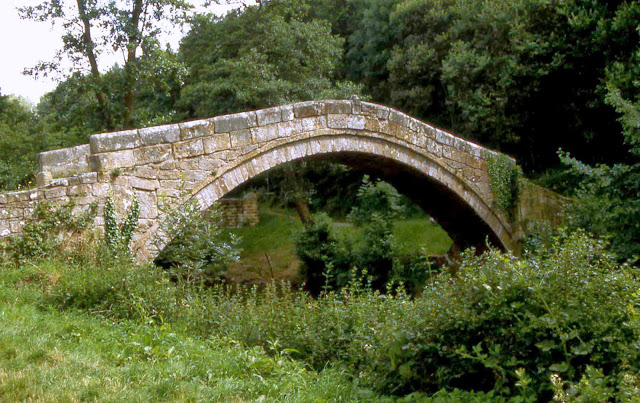Beggar’s Bridge
A fine stone bridge over the
River Esk near to Glaisdale in North Yorkshire
bears the date 1619 and the initials T.F. Thomas Ferris was a young farm labourer who live in Glaisdale in the 17th
century. When young Tom visited his
sweetheart, Agnes Richardson, who lived at Egton on the other side of the
river, he was often obliged to either wade or swim across the sometimes
turbulent river because there was no bridge.
Agnes was the daughter of the local Squire who strongly disapproved of
the relationship and legend has it that Tom went to sea to seek his fortune and
actually sailed on the Spanish Main, where he helped to capture a galleon and
shared in the plunder of gold and precious stones. He returned to marry his sweetheart and
became Lord Mayor of Hull
Tom built Beggar’s Bridge to
fulfil a vow that young lovers in the area would be able to meet under drier
conditions and in gratitude for his own good fortune.
Duck Bridge
Another fine stone bridge spans the Esk near Danby and
bears the coat of arms of the Neville family, important local landowners in the
middle ages. It is known as ‘Duck Bridge
World’s End
A very picturesque packhorse bridge over Codbeck in the
lovely village of
Sowerby North Yorkshire was built in 1672. Known as ‘World’s End’, it was the only way
into the village from the south, other than by ford, until 1929. It is now dwarfed by the huge road bridge
carrying the A168 road as it by-passes nearby Thirsk.
World's End
The Funeral Bridge
The old pack-horse bridge over the River Dulnain at
Carrbridge in Speyside, Scotand, is one of the oldest stone bridges in the
Highlands. It was built in 1717 by a mason called John Niccelsone.
Brigadier-General Alexander Grant of Grant paid for the cost of the Bridge of
£100. The reason that the bridge was built was to ensure that funerals could
still take place at Duthil Church over the river when it was in spate and
unfordable.
It has always been referred to as The Funeral or Coffin Bridge.
The Funeral Bridge
The Funeral Bridge
Photo fromWikipedia Commons
I am grateful for the use of these two photographs
Sweet revenge
A very fine bridge over the River
Teith at Doune, Perthshire, was originally built in 1535, by James Spittal,
wealthy tailor to James 1V. The story
goes that when he arrived at the former ferry without any money, Spittal was refused
passage by the ferryman. He built the
bridge out of spite in order to deprive the ferryman of his living.
Spite Bridge
Devil's Bridge
According to legend the bridge at Kirby Londsdale in Cumbria was built by the Devil. The story goes that an old lady herder had trouble getting to her cattle over the River Lune and made a pact with the Devil who agreed to build a bridge and in return would receive the first soul to cross his bridge. The Devil kept his part of the bargain but the woman coaxed her dog to be the first to cross and so outwhitted the Devil.
This legend may be related to folk memory when it is thought that a dog was sacrificed when bridges were built to guard against the spirits of the river, or to protect the bridge from evil spirits and occurs in various parts of Britain and Europe.
Devil's Bridge
Wansford in England
The village of Wansford England England
This bridge at Fort Augustus at the western end of Loch Ness in Scotland was originally a stone bridge built by soldiers after the Jacobite defeat in 1746. On the main road south it carried,
not only the military but also thousands of cattle, sheep and ponies on the Drove Route to markets in the south.
In 1849 disaster struck when great floods destroyed two of its three stone arches. Local man Joseph Mitchell, who had trained under Thomas Telford whilst building the Caledonian Canal, obtained permission to repair the bridge and used the centuries old trestle style as a 'temporary' repair which is still in position today and is a listed monument. It was subsequently replaced by the fine stone bridge close by as used today and is no longer in use.
A Preservation Trust is hoping to restore this historic bridge to its former state of 1840
The Trestle Bridge
Pultenay Bridge
Built in Bath stone, Pultenay Bridge at Bath crosses the River Avon near the city centre and
was built in 1774. Commisioned by William Johnstone a wealthy lawyer and MP and
named after his wife Frances Pultenay, it was designed in Palladium style by
Robert Adam. It is one of only four bridges in the world with shops across its
full span on both sides. Grade 1 listed,
it is 980ft long and 58ft wide, and is still used by buses and taxis.
Reminiscent of Ponte Vecchio in Florence it is part
of a World Heritage Site.

















No comments:
Post a Comment